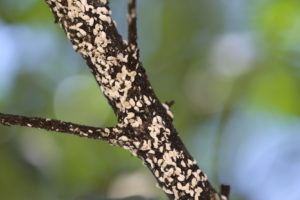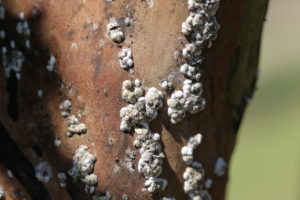A new scale has been observed infesting crape myrtles (Lagerstroemia x indica) in north Louisiana and Texas cities. In the summer of 2016 it was found threatening crape myrtles in the Piedmont area of North Carolina and in west Tennessee (Memphis). Crape myrtle bark scale is a felt scale related to azalea bark scale and oak eriococcin scale. (Eriococcus lagerostroemia). It feeds on plants in Japan and China.
Female scales produce fluffy white filaments that cover their bodies. In spring they produce eggs beneath their body then die. Tiny crawlers hatch from the eggs, settle in their new spot, and begin producing white filaments. They have at least 2 overlapping generations. At low density, crape myrtle bark scale feeds in rough areas around branch collars but as the population increases all the bark may be covered. These scales are most often noticed because trees become covered in black sooty mold. At first many people assume this is from crape myrtle aphids and the scales may go undetected. If you notice unusually heavy honeydew and sooty mold on crape myrtles take a closer look at the bark.
This pest excretes honeydew that coats leaves and limbs, resulting in a sticky coating from the excess sugars excreted from the insects’ feeding. Sooty mold grows on the honeydew. This results in a black (sooty mold) coating that appears on the bark of the branches and trunks of crape myrtles. Additionally, white cases are visible, and they enclose the adult female scales.
Insects appear as white, waxy encrustations likely to occur anywhere on the plant but often near pruning wounds or in branch crotches. Up close, the bark scale insect is white to gray in color. Larger female scales “bleed” a pink liquid when crushed. Crape myrtle scale appears pink in color inside the case. Careful examination may reveal dozens of pink eggs under some of the larger white scale covers.
Recommendations for managing the scale are still being developed; however, current management suggestions for this scale include:
- Wash the trunk and reachable limbs of heavily infested plants with a soft brush and mild solution of dishwashing soap. The egg masses and female scales will be washed off, resulting in improved effectiveness of insecticides. Also, the black mold building up on the bark of infested trees will be removed by washing. The scales and sooty mold may be removed by using water pressure. Removing the loose bark is important because the protected areas where the scales hide are removed. This removes the areas that the scales may use for protection from unfavorable weather in winter.
- First application should be made between May and July with follow-up applications every 3-4 weeks as needed. Systemic insecticides include dinotefuran (Safari™) and imidacloprid (Merit™ or Bayer Advanced Garden Tree and Shrub Insect Control™). Drench applications of neonicotinoids are typically effective against phloem feeders. Read the labels for restrictions on using neonicotinoid pesticide as crape myrtle flowers attract multitudes of beneficial pollinators. Horticultural oil, especially the heavier dormant rate, can also reduce scale numbers.
If you find this scale on your crape myrtles, take a sample to the local Extension office for identification.
Credit: information for this blog supplied by the Extension Services of Louisiana State University in Baton Rouge and University of Tennessee in Knoxville.



 Posted in
Posted in 
